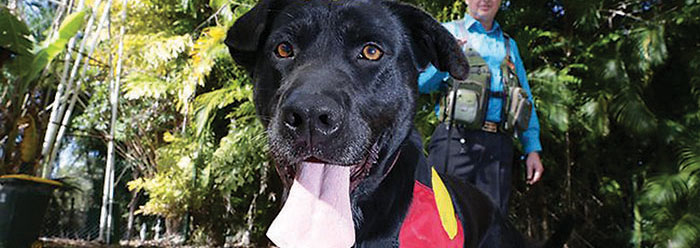Gary Jackson and his dog, Migaloo, trained to sniff out buried remains, work with local Australians to uncover archaeological sites and help police locate the remains of murder victims. According to The Sydney Morning Herald, “Migaloo quickly located the 600-year-old remains of an indigenous Australian,” which researchers found a decade ago.1 But her specialized training resulted in an unforeseen crossover—Migaloo can also smell fossils.
A dog should not be able to smell fossils if the standard fossil formation story is true. This scenario assumes trickling minerals slowly replaced long-dead bones over millions of years. This process supposedly replaced all original bone material, essentially forming rocks that preserve only the bone shapes. If true, then the bones should no longer smell any different than the surrounding rock.
Animal remains buried for several dozen or maybe even several thousand years might retain some of their original organic components. But that would require special conditions, like rapid burial followed by quick drying, to protect the remains from hungry microbes. Since all rocks are porous, no underground encasing could indefinitely protect remains from chemical reactions.2 If the original material was not replaced by minerals, then it would have decayed and disappeared long before a million years elapsed—especially under a warm Australian climate.
Apparently, nobody explained these complicated fossilization issues to Migaloo and her sensitive sniffer. The black Labrador-bull mastiff identified megafauna bone remains tagged at 2.6 to 5.3 million years old.3 How did she do it?
University of Queensland paleontologist Steve Salisbury told The Herald, “It seems very feasible to me that there would still be odour attached to a corpse but fossil bone is another thing. We’re talking millions of years old, where the original bone and internal structure has been re-mineralised and essentially become a rock. That’s why I question whether she can smell the difference.”1
Why does Salisbury prefer the undemonstrated age assignment over Migaloo’s demonstrated ability to smell fossils? The dog did smell something different, showing that underground processes never did re-mineralize those fossil bones—at least not entirely. And if they still retain original organics, then they are not millions of years old. Shouldn’t a scientist follow the observable evidence instead of blindly believing in millions of years?
After all, paleontologists continue to find un-mineralized fossils—fossils that clearly contain original proteins and cells—designated as tens of millions of years old from numerous U.S. states, Brazil, Argentina, Great Britain, Germany, several Chinese provinces, Italy, and Belgium. Studies continue to identify animal proteins in deeply buried fossils, including collagen, elastin, ovalbumin, histone, keratin, osteocalcin, and even hemoglobin. Time has taken its toll on these long-buried proteins, but they retain enough of their original integrity for clear identification.4 The still-intact organic molecules inside these fossils indicate they are many times younger than tens of millions of years. So there’s every reason for skepticism over the age range assigned to the fossils that Migaloo sniffed out.
“I’d like to believe it. If she can find fossilised bone, then that would make our searches a lot easier. I’m ready to watch and be surprised—that would be really exciting,” Salisbury said.1
Jackson continues to train and test Migaloo’s potential. If she emerges as a bona fide fossil-smelling dog, she would demonstrate something much more exciting than easing fossil searches—her nose would show why original organic materials in fossils should influence a reassessment of secular ages.
References
- Mann, E. Migaloo the super snout’s on the case. The Sydney Morning Herald. Posted on smh.com.au April 28, 2013, accessed May 19, 2013.
- Specifically, bone collagen turns to dust after 700,000 years at 50°F. Its time-to-dust estimate is less than 15,000 years at 70°F. See Buckley, M. and M. J. Collins. 2011. Collagen survival and its use for species identification in Holocene-lower Pleistocene bone fragments from British archaeological and paleontological sites. Antiqua. 1 (1): e1.
- “Megafauna” means “large animal” and often refers to large animal varieties that existed during and after the Ice Age but have since gone extinct, like the giant moa bird that once alive in Australia.
- Many of these finds are described at www.icr.org/fresh-fossils.
* Mr. Thomas is Science Writer at the Institute for Creation Research.
Cite this article: Thomas, B. 2013. How Does a Dog Smell Fossils? Acts & Facts. 42 (8): 14.














